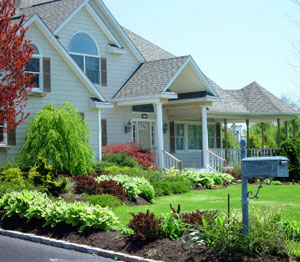In Business Since | License #
In Business Since | License #

A heat pump can keep your living space warm during winter months, and also provide cooling on hot summer days. This dual-purpose capability goes a long way toward explaining why heat pumps are so popular: Instead of having separate furnace and central air conditioning systems installed to provide heating and cooling, the heat pump accomplishes both tasks. People also like heat pumps because they're quiet and there's no fuel required. Electricity is the power source for all heat pumps.
Dr. Energy Saver has proven heat pumps already in use in thousands of homes across the country. Contact your local dealer to see how heat pumps could benefit your home!

Heat pumps can help homes of many shapes and sizes achieve comfort and energy efficiency.
The technology that makes a heat pump work has been around for a long time. Refrigerators, ice makers and freezers all utilize heat pumps that are similar to the larger units used in houses and commercial buildings. Just as the name suggests, a heat pump works by moving (pumping) heat from one location to another. The basic cycle that an "air-source" heat pump uses to heat the air in a forced-air HVAC system is described below.
The cycle starts outside the house, as a fan pulls outside air over tubing coils that contain a liquid refrigerant. Because the refrigerant has a very low boiling point, even air with a temperature in the 40 degree range can cause the refrigerant to turn from a liquid into a gas. Just like the steam created by boiling water, this gas contains heat energy, and it's amplified when the refrigerant vapor is pumped through a compressor. Now much hotter than before, the vapor moves into interior coils that act as a heat exchanger. Cool return air from the home’s ductwork system is blown over the hot coils, and the resulting hot air is then distributed throughout the house. As the refrigerant gives us its heat, it turns back into a liquid, then returns to the outdoor coil so that the cycle can repeat.
During hot weather, the heat pump cycle works in reverse to cool interior air. Refrigerant enters the indoor coil as a liquid, and is vaporized as it absorbs heat from inside the house. The heat is "moved" outdoors, allowing cool liquid refrigerant to be pumped to the indoor coil that cools interior air.
Air-source. More air-source heat pumps are installed than any other kind. This type of heat pump is easy to spot: A concrete slab positioned close to the house supports a vented metal housing that contains the outdoor coil, fan, compressor and circuitry. An air-source heat pump can be linked to a whole-house forced-air heating and cooling system, or it can take the form of a ductless “mini-split” system that forgoes ductwork in favor of compact air-handler units that blow conditioned air into individual rooms. Cold winter temperatures are the main limitation of all air-source heat pumps. The heating cycle of an air-source heat pump becomes inefficient as outside temperatures approach freezing. Air-source heat pumps installed in cold climates often include electric coils, or backup heating systems fueled by gas or fuel oil.
Ground-source. Also known as “geothermal” heat pumps, this type of heat pump is considered by many to be the most energy-efficient HVAC system available. A ground-source heat pump can work at the same high efficiency all the time, because it doesn’t depend on outside air temperature. Instead, a ground-source heat pump utilizes the consistent 55-65 degree temperature of the earth about 6-8ft. below grade level. This ground temperature ensures very efficient year-round performance of a heat pump, regardless of the temperature outside. To transfer the earth’s temperature to the heat pump’s coil, water or an antifreeze solution is circulated through a long run of plastic tubing that is buried in the ground. Depending on how much land is available and how rocky the soil is, the tubing run for a ground-source heat pump can extend horizontally, vertically, or in overlapping coils. The cost of excavating and/or drilling and installing the tubing are what make ground-source heat pumps so expensive. A ground-source heat pump can easily cost five times more to install than an air-source heat pump.
Once you have decided to install an air-source or ground-source heat pump, it will be necessary to size the heat pump and narrow down your choices based on cost and efficiency. A heat pump is typically sized by the “ton,” a measurement based on the amount of cooling that would be provided by melting a ton of ice. It’s usually recommended to have one ton of capacity for every 400-500 square feet of living area. An experienced HVAC contractor will factor in the size and energy efficiency of your house to get an accurate system size.
A heat pump’s heating efficiency is expressed at HSPF, or heating system performance factor. Cooling efficiency is denoted as Seasonal Energy Efficiency Ratio, or SEER. The most efficient heat pumps range between 8-10 HSPF and 14-18 SEER.
Looking for a price? Get a no cost, no obligation free estimate.